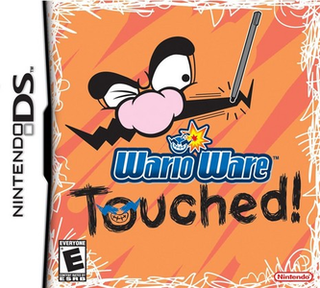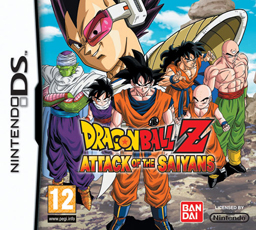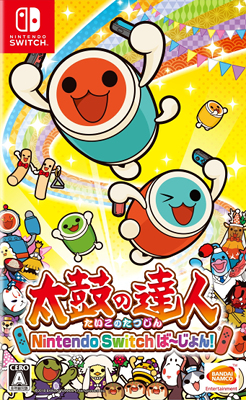
The Tales series is a franchise of fantasy role-playing video games published by Bandai Namco Entertainment, and developed by its subsidiary, Namco Tales Studio until 2011 and presently by Bandai Namco Studios. First begun in 1995 with the development and release of Tales of Phantasia for the Super Famicom, the series currently spans seventeen main titles, multiple spin-off games and supplementary media in the form of manga series, anime series, and audio dramas.

Mr. Driller is a puzzle video game franchise created by Yasuhito Nagaoka and Hideo Yoshizawa for Namco. The eponymous first game was released in 1999 for arcades and several home consoles, such as the PlayStation. Gameplay in the series consists of controlling Susumu Hori, the titular Mr. Driller, or one of his friends and destroying colorful formations of blocks to make it to the bottom of a well. In order to survive, players need to collect air capsules to replenish their depleting oxygen and avoid being crushed by falling blocks.

WarioWare: Touched! is a minigame compilation party video game released by Nintendo for the Nintendo DS. The fourth installment of the WarioWare series, and the first of three on the Nintendo DS, the game involves rapidly completing "microgames" — simple minigames lasting extremely short periods of time — as quickly as possible. The microgames are exclusively controlled with the Nintendo DS's touchscreen and microphone.

Mr. Driller Drill Spirits is a 2004 puzzle video game developed and published by Namco for the Nintendo DS. Controlling one of six characters, the player must make it to the bottom of each stage by destroying, colored formations of blocks while preventing their oxygen meter from depleting. Multiple different gamemodes are present, including a single-player campaign, a time-attack mode, and a competitive multiplayer mode. It is the sixth entry in the Mr. Driller series.
Mario Kart Arcade GP is a sub-series of arcade games in Nintendo's Mario Kart series developed specifically for arcades in collaboration with Namco. To date, four entries have been released—Mario Kart Arcade GP (2005), Mario Kart Arcade GP 2 (2007), Mario Kart Arcade GP DX (2013), and Mario Kart Arcade GP VR (2017). The first three entries are considered to be relatively rare outside of Japan, with the fourth title not seeing a release outside of Japan at all. The games have been generally been well-received by critics, who have praised the game's transition of traditional Mario Kart gameplay into an arcade game format, while lamenting that none of the entries have been released outside of the arcade format onto any of Nintendo's home video game consoles.

Kotoba no Puzzle: Mojipittan is a series of Japanese word puzzle video games developed and published by Bandai Namco Entertainment, formerly Namco. The series began in arcades with Kotoba no Puzzle: Mojipittan in 2001, and has seen multiple sequels for several platforms, including the Game Boy Advance, PlayStation Portable and Nintendo DS. Gameplay is similar to Scrabble — players are tasked with using Hiragana to form words on a board by placing down pieces marked with Hiragana characters.
Point Blank, known as Gun Bullet, or Gunvari in Japan, is a series of light gun shooter games developed by Namco for the arcade, PlayStation and Nintendo DS; the trilogy was first released in arcade in 1994 and was later ported onto the PlayStation. Point Blank DS was released in 2006 for the Nintendo DS featuring 40 challenges from the original series.

Asterix & Obelix XXL 2: Mission: Las Vegum is an action-adventure game developed by Etranges Libellules for Windows and PlayStation 2, the sequel to Asterix & Obelix XXL. It was released in June 2006 in Europe. The game stars the French comic book characters Asterix and Obelix, and features spoofs to numerous classic games, in the same fashion that the comics spoof historical characters and make many cultural references. One such example of this is the box art that has a resemblance to the one seen in Grand Theft Auto: San Andreas.

Point Blank DS is a 2006 lightgun shooter video game developed and published for the Nintendo DS by Namco Bandai Games. It is the fourth entry in the Point Blank series, comprising both new stages and ones taken from the first three games. Players use the touch screen to complete a number of different minigames that vary in terms of mechanics, such as protecting an on-screen character or shooting down a specific target.

Taiko no Tatsujin is a Japanese video game series created by Namco. In the games, players simulate playing a taiko drum in time with music. The series has released games for the arcade and for console and mobile platforms including PlayStation 2, Advanced Pico Beena, PlayStation Portable, Nintendo DS, Wii, Nintendo 3DS, Wii U, PlayStation Vita, PlayStation 4, PlayStation 5, Nintendo Switch, Xbox One, Xbox Series X/S, Microsoft Windows, iOS, Android and Japanese feature phones.

Flash Focus: Vision Training in Minutes a Day is a Touch! Generations puzzle video game developed by Namco Bandai and Nintendo SPD and published by Nintendo for the Nintendo DS handheld video game console. It was released in Japan on May 31, 2007 as Miru Chikara wo Jissen de Kitaeru: DS Medikara Training and released in North America on October 15.

Namco Museum DS is a 2007 video game compilation developed by M2 and published by Namco Bandai Games. The game features 7 arcade games previously published by Namco along with a Nintendo DS version of the Nintendo-developed title Pac-Man Vs.

Picross 3D, known in Japan as Rittai Picross, is a puzzle video game developed by HAL Laboratory and published by Nintendo for the Nintendo DS. It was released in Japan in March 2009, in Europe in March 2010, and in North America in May 2010. It uses similar nonogram mechanics to Picross DS, but adapted to a three-dimensional environment by adding an extra axis blocks can go on. Outside Japan, the game is part of Nintendo's Touch! Generations brand. It was also released for the Wii U's Virtual Console in Europe and Japan in 2016 and North America in 2017. A sequel, Picross 3D: Round 2, was released for the Nintendo 3DS in Japan in October 2015, in North America in September 2016, and in Europe and Australia in December 2016.

Dragon Ball Z: Attack of the Saiyans, known in Japan as Dragon Ball Kai: Saiyan Invasion, is a video game based on the Dragon Ball franchise for the Nintendo DS. It was released in Japan on April 29, 2009, and in Europe and North America in November 2009. The game is developed by Monolith Soft and distributed by Namco Bandai in North America ; it is one of the first games in the Dragon Ball franchise to be published by Namco Bandai, as the company would acquire the license from previous holder Atari in July of the same year.

Dragon Ball: Origins 2, known as Dragon Ball DS 2: Charge! Red Ribbon Army in Japan, is a video game for the Nintendo DS based on the Dragon Ball franchise and the sequel to 2008's Dragon Ball: Origins. The game was developed by Game Republic and published by Namco Bandai throughout North America and everywhere else under the Bandai label. Released in 2010.

Dragon Ball Kai: Ultimate Butōden is a fighting video game for the Nintendo DS based on the Dragon Ball franchise. It was released only in Japan on February 3, 2011.

Taiko no Tatsujin: Drum 'n' Fun!, released in Asia as Taiko no Tatsujin: Nintendo Switch Version!, is a rhythm game developed by Bandai Namco Studios & DokiDoki Groove Works and published by Bandai Namco Entertainment. It was first released in Japan and other parts of Asia in July 2018, and in North America, Europe and Australia in November. The title's release marks the first release of a Taiko no Tatsujin game to Western audiences in over a decade. It was delisted from the Nintendo eShop in November 2023.

Sailor Moon: La Luna Splende is a video game developed by Open Sesame and published by Namco Bandai Games for the Nintendo DS and released in Italy on 16 March 2011. The title is inspired by the anime series Sailor Moon, and although the title of the video game refers to the Italian title of the second season, its plot and player characters are specific to the first season.

Mizuiro Blood is a hybrid edutainment/minigame compilation video game developed and released in Japan for the Nintendo DS by Namco Bandai Games in 2007.

Pac-Man 99 was a maze video game with battle royale elements developed by Arika and published by Bandai Namco Entertainment for the Nintendo Switch. It was released through the Nintendo Switch Online service on April 7, 2021.

















